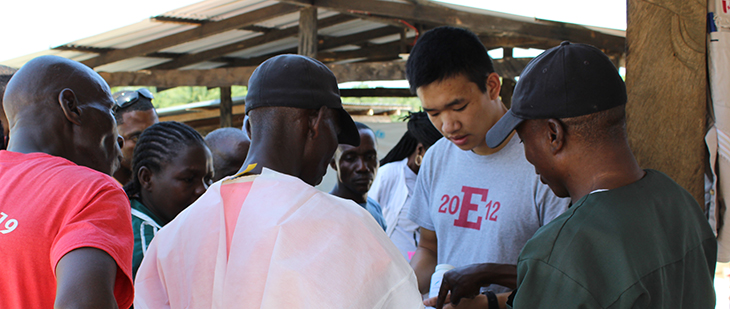Jason Kang ’12

Editor’s note: Since this feature was published, Jason Kang and Kinnos have continued on their trajectory of success. Kinnos recently launched a second product, Highlight Wipes, designed to fight preventable infection in hospitals.
Accolades continue to come: the United States Patent and Trademark Office awarded Kinnos a 2018 Patents for Humanity award for its ongoing work in fighting Ebola contamination, and Kang was named a 2018 Bluhm/Helfand Social Innovation Fellow for his work “building solutions that positively impact the world.”
Kang returned to campus in January 2019 to present an assembly. “The most difficult part of innovation is finding problems worth solving,” the ESSO veteran told students. When asked how he knows he’s having an impact, Kang responded with candor. “I am working on just one of many problems out there.” He sometimes wonders, he explained, if it makes more sense to provide basic resources — food and water — to the populations that use his Highlight product to counter Ebola. Ultimately, he feels he is doing important work “if people can now go to hospitals and not be afraid their lives are at risk from infection.”
Outfoxing Ebola
The company’s name, Kinnos, is a short compound word with a simplicity that belies its potentially profound impact in the battle against infectious diseases and encapsulates the drive of its founders to create products that keep others safe, explains co-founder Jason Kang ’12.
”It’s a mix of ’kin,’ which connotes family, longevity and life, and ’nos,’ which is short for diagnosis and a reminder that our first product, Highlight, is but one of many we can create,” he says.
Kang’s eagerness to look to the future is inspiring, particularly given that the young inventor and his two co-founders — recently named to the 2016 Forbes 30 Under 30 in Health Care — have not yet graduated from college. A senior in biomedical engineering at Columbia University, Kang and fellow students Katherine Jin and Kevin Tyan came up with their inaugural product in 2014, in response to the Columbia Ebola Design Challenge. ”One of the biggest issues at the time was ineffective decontamination, which led to health care workers, first responders and doctors being infected at disproportionately high rates,” Kang explains. ”We quickly realized that the biggest problem with bleach, the most commonly used disinfectant, was that it’s clear, making it impossible for users to guarantee that a surface has been completely covered.
Kang’s initial instinct: colorize. ”My first thought was to design a hazmat suit that changed colors, thereby making it easier to confirm effective decontamination,” he recalls, ”but then Kevin said, ’Why not just colorize the disinfectant instead?’ ” As the trio continued to develop their ideas, they realized that disinfectant runoff and evaporation were issues as well. Similar to rain hitting an umbrella, bleach forms droplets and rolls off surfaces, leaving gaps in coverage. ”Bleach also evaporates in two to three minutes, while the World Health Organization recommends a 10-minute exposure to the decontaminant,” Kang says, ”and it releases chlorine gas upon evaporation, which has negatively impacted the health of many health care workers.”
The team’s winning solution: a powdered additive that colorizes the bleach and modifies its liquid properties so that it fully coats surfaces and evaporates more slowly. The color fades over time to prevent staining and indicate to users when decontamination is complete. Their idea was simple, inexpensive and easy to incorporate into any protocol, as it requires no new equipment, training or materials.
The trio began making Highlight in October 2014, with Columbia assisting them with publicity. It caught the eye of the New York City Fire Department’s chief medical officer, Dr. David Prezant, himself a Columbia grad, and in December 2014 the FDNY incorporated Highlight into its decontamination protocol. ”At that point we realized that this was not just a project but a viable business,” Kang says.
Kang and his colleagues continued to refine their product, teaming with Columbia’s Center for Infection and Immunity to test Highlight’s viability on different diseases and ensure that the additive enhanced the visual and physical properties of various antivirals without reducing their efficacy. ”The Center for Infection and Immunity was incredibly helpful during our earlier stages of prototyping,” Kang notes.
In February 2015 the trio garnered additional attention when they were selected as one of 14 winners of the USAID Fighting Ebola Grand Challenge, the only undergraduate team to win against more than 1,500 international applicants. ”That victory was really big for us,” Kang says. ”The win secured us over $500,000 in grant money from USAID and enabled us to meet many valuable new contacts.” Kinnos is now fielding inquiries from NGOs and the New York City Department of Health to Amtrak and a contractor for the U.S. military.
Perhaps the greatest benefit of the win, however, was the opportunity it afforded Kang and his fellow inventors to travel to Liberia to field-test their product. ”It was an extraordinary experience to see how hard these first responders are working and how helpful Highlight could be to them,” he says. ”It was powerful validation to see end users benefit from the product we’ve created.”
— Lori Ferguson
Editor’s note: This article first appeared in the winter 2016 issue of The Exeter Bulletin.